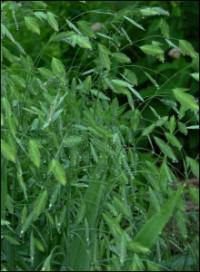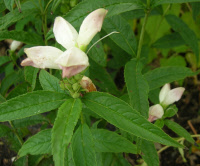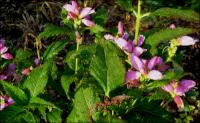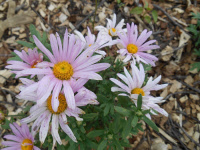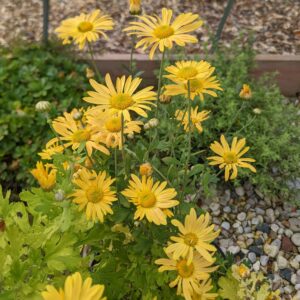Shop
Showing 177–184 of 788 results
-
Chasmanthium latifolium Northern Sea oats Z 5-9
Graceful, pendulous oat-like spikes
In August – December Northern sea oats bear pendulous panicles of oat-like spikelets, emerging green and turning bronze. They hang on all winter.
Size: 36" x 24"
Care: full sun to part shade in any soil
Native: Eastern U.S., New Jersey to Texas
Wildlife Value: attracts butterfliesIntroduced by Michaux (1746-1802) extraordinary French plant hunter, who searched much of eastern No. America for plants. Indians ate the seeds for food. Used ornamentally since Victorian times for fresh and dried arrangements.
-
Chelone glabra White turtlehead Z 3-8
Spikes of pink over-tones on white, two-lipped, turtlehead shaped blooms in fall
Spikes of pink over-tones on white, two-lipped, turtlehead shaped blooms in fall
Size: 24-36” x 12”
Care: sun to part shade in moist to moist well-drained soil, tolerates clay.
Native: eastern North America incl Wisconsin
Wildlife Value: Pollen for bumblebees. Breeding site for Baltimore Checkerspot butterflies. Deer resistant.The name Chelone originated with French colonial settlers in Nova Scotia before 1700. They called this “La Tortue,” meaning “turtle” in French. The word chelone is Greek for tortoise. A tea brewed from the leaves was said to increase the appetite.
-
Chelone obliqua Rose turtlehead Z 5-9
Rich pink turtlehead shaped blooms in fall
OUT OF STOCK
Rich pink turtlehead shaped blooms in fall
Size: 16-24" x 12"
Care: Part shade moist to moist well-drained soil, tolerates clay
Native: Central and southeastern America
Wildlife Value: Attracts Baltimore Checkerspot butterflies.The name Chelone originated with French colonial settlers in Nova Scotia before 1700. They called this plant’s white-flowered relative (Chelone glabra) “La Tortue,” meaning “turtle” in French. This pink one found in 1752 by Virginia plantsman John Clayton and sent to John Bartram in Philadelphia in 1765. Called the “red Chelone.” A tea brewed from the leaves was said to increase appetite.
-
Chrysanthemum alpinum syn. Luecanthemopsis alpina Alpine daisy Z 5-
Short white daisies blooming June-August atop basal foliage, spreads to form small mat.
ARCHIVED
Note: This is a plant not currently for sale. This is an archive page preserved for informational use.
Short white daisies blooming June-August atop basal foliage, spreads to form small mat.
Size: 4” x spreading
Care: full sun in well-drained soil
Native: mountains of Europe1st described by French botanist Tournefort, early 1700’s. Wm. Robinson (1883): “A very dwarf plant. The leaves are small, and the abundant flowers are supported on hoary little stems 1 to 3 inches long, are pure white with yellow centres, and are more than 1” across… well deserves cultivation in bare level places, on poor sandy or gravely soil in the rock garden.”
-
Chrysanthemum parthenium syn. Tanacetum parthenium Feverfew Z 5-9
Cheerful, small white daisies flower all summer and autumn
ARCHIVED
Note: This is a plant not currently for sale. This is an archive page preserved for informational use.
Cheerful, small white daisies flower all summer and autumn.
Size: 18-24” x 12”
Care: Full sun moist well-drained soil
Native: Europe and CaucasusCommon name “Feverfew” speaks for itself, referring to the plant’s medicinal qualities. The species’ name parthenium comes from Plutarch who claimed that the plant saved the life of a construction worker who fell from the Parthenon. Feverfew was prescribed to remedy coughs, indigestion, congestion, melancholy, hysteria, vertigo, freckles, opium overdoses and for “them that are giddie in the head.” Parkinson. A favorite early cottage garden flower. Pressed specimen in Emily Dickinson’s herbarium.
-
Chrysanthemum serotinum syn. Leucanthemella serotina Autumn oxeye, Giant daisy Z 4-8
Pure white daisies with golden centers, 2-3” across, aren’t just for summer. This one celebrates the fall.
ARCHIVED
Note: This is a plant not currently for sale. This is an archive page preserved for informational use.
Pure white daisies with golden centers, 2-3” across, aren’t just for summer. This one celebrates the fall.
Size: 4-7’ x 12-24”
Care: sun in moist to moist well-drained soil
Native: SE Europe & Balkans
Wildlife Value: Attracts bees, butterflies and hummingbirds
Awards: Royal Horticultural Society Award of Garden MeritDescribed by Linnaeus 1753. The Gardeners Dictionary (1783): “This grows naturally in North America but hath long been preserved in English gardens. …each(stalk) being terminated by a large, white, radiated flower; these appear in September. It multiplies very fast by its creeping roots.”
-
Chrysanthemum x rubellum ‘Clara Curtis’ Z 4-9
Late-summer - fall, sprays of large, single pink daisies, each with a golden eye.
Late-summer – fall, sprays of large, single pink daisies, each with a golden eye.
Size: 2’ x 2’
Care: Sun to part shade in any soil. Pinch back half way in June to keep plants bushy.Korean hybrids, of which this is one, created in 1937 by crossing early flowering mum with Chrysanthemum coreanum.
-
Chrysanthemum x rubellum ‘Mary Stoker’ Z 4-9
Sprays of large, single warming yellow daisies, blushed with apricot top a bushy mound of light green leaves, Blooms late-summer to late-fall
OUT OF STOCK
Sprays of large, single warming yellow daisies, blushed with apricot top a bushy mound of light green leaves, blooms late-summer to late-fall
Size: 1-2’ x 2-3’ and spreading
Care: Full sun to part shade, tolerates normal, sandy or clay soil
Wildlife Value: Attracts bees, butterflies and birds. Deer resistant.One of the rubellum hybrids, Hybridized in the 1930’s

